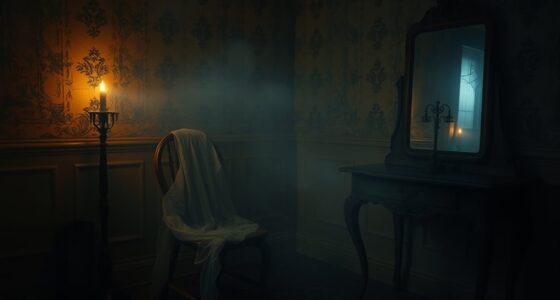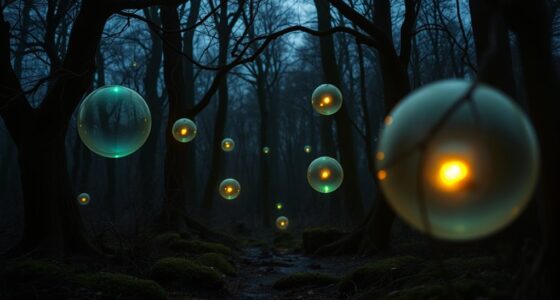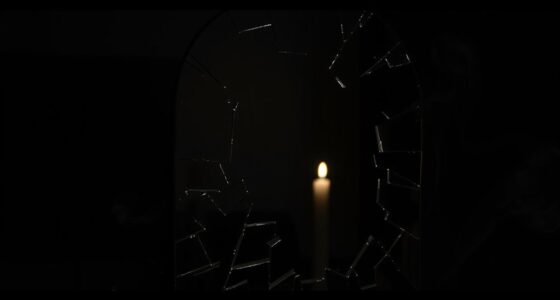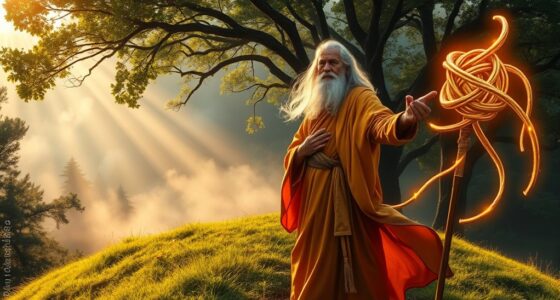Demons and ghosts might seem similar, but they have clear differences. Demons are supernatural beings from religious and mythological stories that symbolize evil, chaos, and temptation. Ghosts are spirits of the deceased who linger due to unresolved issues or spiritual connections. Their appearances, behaviors, and roles vary across cultures. If you want to uncover more about their origins, myths, and how they influence culture, keep exploring these fascinating differences.
Key Takeaways
- Demons are malevolent, aggressive supernatural beings often linked to evil, while ghosts are spirits of the deceased, usually unresolved or restless.
- Demons typically have distorted, intimidating forms; ghosts appear as translucent, flickering figures or shadowy apparitions.
- Demons aim to manipulate or possess humans; ghosts generally linger due to unresolved issues or spiritual bonds.
- Cultural beliefs portray demons as chaos or temptation, ghosts as ancestors or guiding spirits, influencing rituals and societal norms.
- Media often conflates or exaggerates their traits, but scientifically, most hauntings are natural phenomena or psychological responses.
Origins and Cultural Roots of Demons and Ghosts
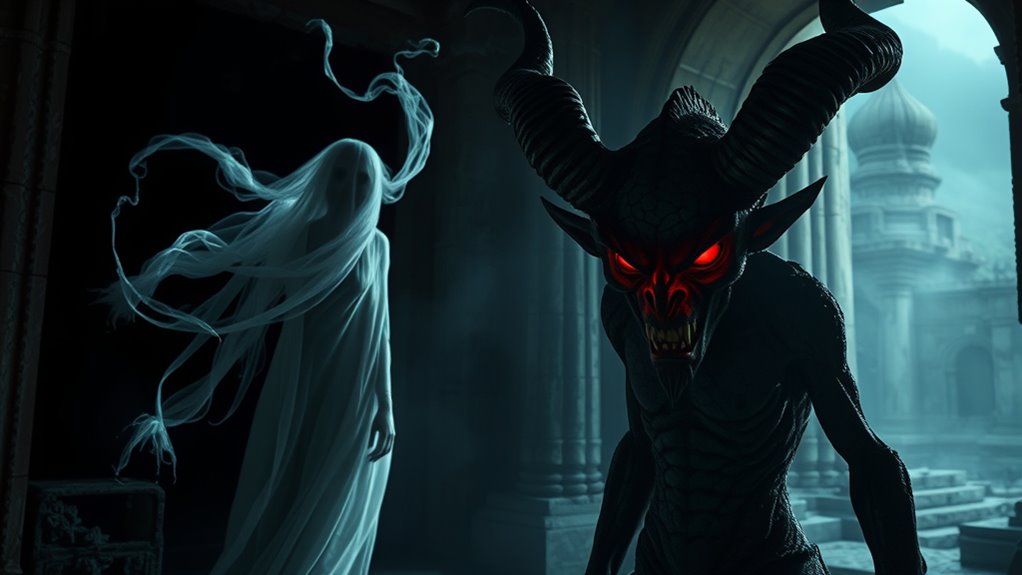
The origins of demons and ghosts are deeply rooted in diverse cultural and religious traditions around the world. Historical symbolism reveals how societies used these figures to embody fears, morality, and spiritual beliefs. Demons often symbolize evil, temptation, or chaos, appearing in religious texts and myths to represent moral struggles. Ghosts, on the other hand, serve as literary references to unresolved spirits or ancestors seeking closure. These entities reflect cultural values and societal fears across civilizations, from ancient Mesopotamian legends to Asian folklore. Over time, stories about demons and ghosts have evolved, shaping perceptions and beliefs. Understanding their origins helps you see how different cultures interpret the supernatural, blending historical symbolism with storytelling to explain the unknown. Additionally, mythological representations have played a significant role in shaping contemporary ideas about these entities, often influenced by cultural narratives that have persisted through generations. Recognizing the symbolism of supernatural beings provides insight into the moral and societal structures of various cultures. Moreover, the psychological impact of these stories has contributed to their enduring presence in folklore and popular culture, influencing how societies cope with fears and uncertainties. It is also important to consider how goal tracking in folklore and storytelling helps societies process and understand these complex ideas.
Physical Appearance and Manifestations
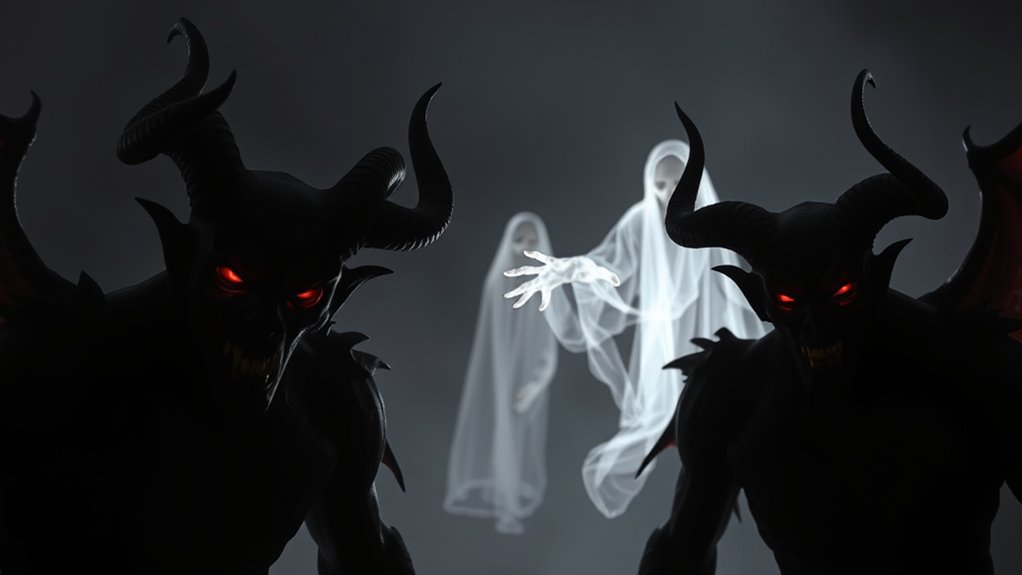
Demons and ghosts often reveal themselves through striking and eerie appearances that vary across cultures and stories. You might see demons with distorted, intimidating forms or ghosts as translucent figures flickering with spectral flashes. These visual distortions create a sense of unease, emphasizing their supernatural nature. Demons typically appear as monstrous or fiery beings, while ghosts often take the shape of lost loved ones or shadowy apparitions. For instance, some stories depict demons with a menacing aura that heightens their intimidating presence in visual representations.
Behavioral Traits and Interactions With Humans
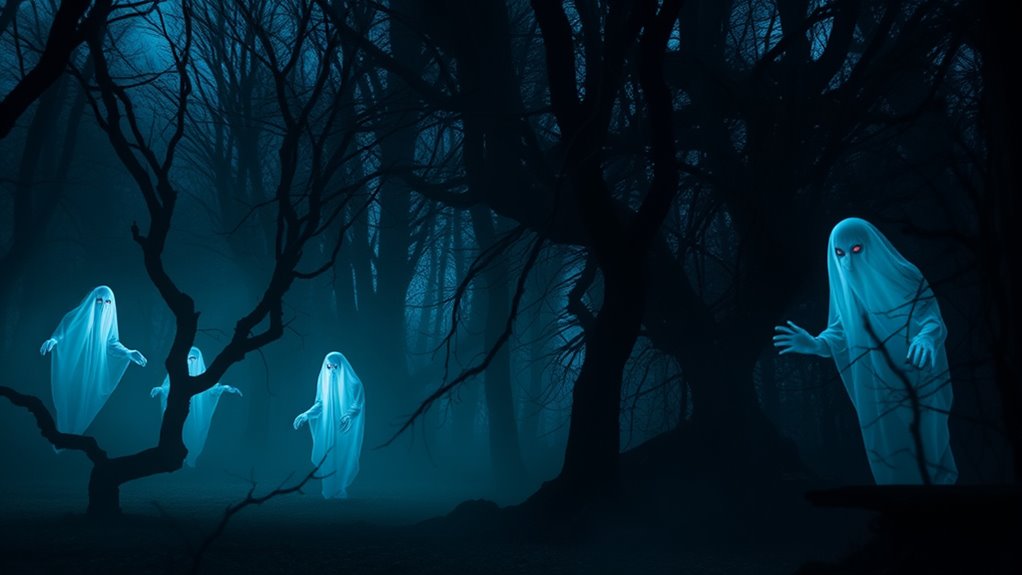
While demons often seek to dominate and instill fear through aggressive and destructive behaviors, ghosts tend to linger with more subtle, restless intentions. You might notice ghostly activity in haunted locations, where unexplained noises, cold spots, or apparitions appear without direct aggression. Ghosts are less likely to possess animals or influence their behavior, but they can cause animals to act strangely, sensing unseen presences. Demons, however, are more proactive and manipulative, often attempting to possess or control humans and animals alike, to exert power or cause chaos. Their interactions tend to be more hostile and invasive, aiming to destabilize emotionally or physically. Ghosts usually stay within the domain of lingering memories or unfinished business, whereas demons actively seek to dominate or harm. Understanding behavioral traits and how these entities interact with humans can help in differentiating between the two. Additionally, the nature of interactions with humans often reveals the entities’ true intentions and origins. Recognizing demonic behaviors such as aggressive attempts at possession can further aid in distinguishing them from ghostly phenomena. Awareness of spiritual influences can also provide insight into how these entities manipulate or affect human emotions and environments. Moreover, ethical hacking principles reveal that understanding the tactics used by malicious entities can help in developing effective defenses against harmful influences.
The Roles and Functions in Different Mythologies

You’ll see how demons and ghosts serve different purposes across cultures, shaping beliefs and traditions. Their roles reveal what societies value, fear, and seek to understand about the unseen world. By exploring these variations, you’ll gain insight into how mythology reflects each culture’s unique worldview. Additionally, understanding the mythological roles of these entities helps clarify their significance within religious and cultural narratives. Recognizing cultural symbolism associated with demons and ghosts can deepen our comprehension of their distinct functions and the underlying societal themes they embody. Moreover, examining cross-cultural variations highlights how different societies interpret similar supernatural entities to reinforce social norms and moral lessons. Exploring mythological functions offers a broader perspective on how these entities influence cultural identity and moral frameworks. These differences also demonstrate how mythology adapts to the specific fears and hopes of each society, providing a rich tapestry of cultural storytelling.
Cultural Significance and Roles
Have you ever wondered why demons and ghosts hold such powerful roles in various cultures? They serve as symbols of both fear and respect, embodying cultural symbolism that shapes societal values. For example, in some traditions, demons symbolize chaos, prompting rituals to ward them off, reflecting their ritual significance. Ghosts often represent ancestors or spirits needing honor, reinforcing cultural bonds. Here’s a quick look at their roles:
| Culture | Demon Role | Ghost Role |
|---|---|---|
| Chinese | Guardians or malevolent spirits | Ancestral spirits, guiding the living |
| Western | Symbols of evil, temptation | Reminders of past lives, memory |
| Japanese | Yokai as protectors or troublemakers | Ancestral reverence, spirits of the dead |
| African | Nature spirits, protectors or punishers | Ancestors’ spirits, community bonds |
These roles highlight their cultural symbolism and ritual significance across societies.
Mythological Functions and Purposes
Demons and ghosts serve essential mythological functions that go beyond cultural symbolism, acting as agents to explain natural phenomena, enforce moral codes, and maintain social order. They embody moral implications and serve as powerful symbols within mythologies.
Consider these roles:
- Explaining natural events—ghosts often represent ancestors or spirits linked to environmental changes.
- Enforcing moral behavior—demons symbolize evil, warning against immoral actions.
- Upholding social order—both creatures reinforce societal norms through mythological symbolism.
- Guiding the dead—ghosts act as messengers or guides for souls in the afterlife.
Variations Across Cultures
Across different cultures, the roles and functions of demons and ghosts vary considerably, shaped by each society’s beliefs, environment, and history. In some folklore traditions, demons are seen as powerful, malevolent mythical creatures that challenge moral boundaries, while in others, they serve as protectors or catalysts for personal growth. Ghosts often embody spirits of the departed, guiding or warning the living, but their significance differs widely—sometimes as vengeful revenants or as benevolent ancestors. These variations reflect unique cultural values and fears, influencing stories and rituals. For example, Asian cultures may emphasize ancestral ghosts’ respect, while Western folklore often depicts demons as destructive forces. Understanding these differences helps you appreciate how mythological creatures adapt to and mirror the diverse worldviews of societies worldwide.
Common Misconceptions and Myths Debunked
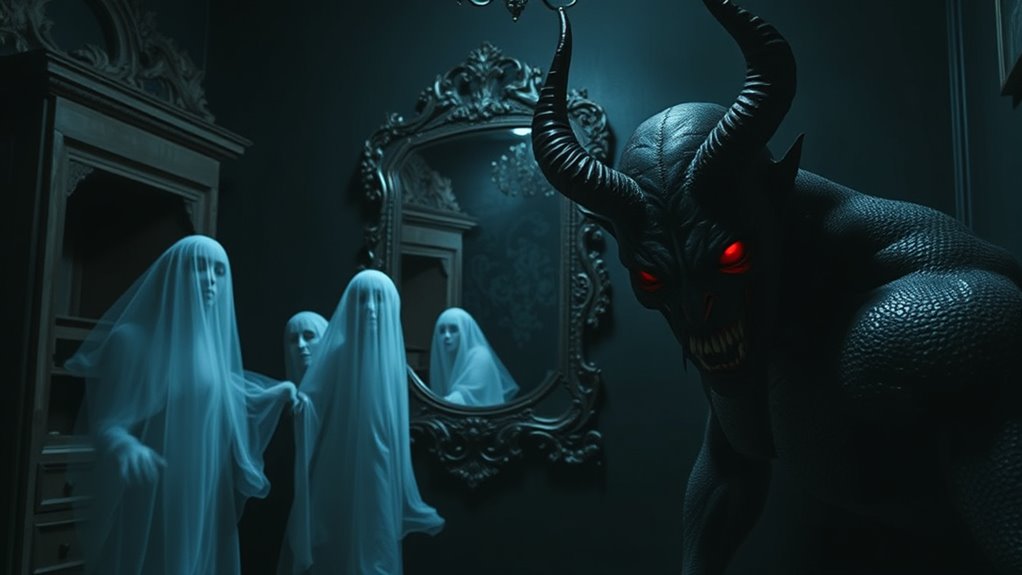
Many popular beliefs about demons and ghosts are based on misconceptions and myths that have persisted for centuries. You might think that all haunted locations are the result of malevolent spirits, or that exorcism rituals always solve paranormal problems. Here are some truths to contemplate:
- Not every haunted location is caused by demons; many are simply the result of environmental factors or folklore.
- Exorcism rituals are often misunderstood and are not always necessary or effective.
- Many ghost sightings are misinterpreted natural phenomena or psychological responses.
- Demons and ghosts are often conflated, but they have distinct origins and characteristics.
Understanding these myths helps you separate fact from fiction and approach paranormal topics with a clearer perspective.
The Spiritual and Religious Significance
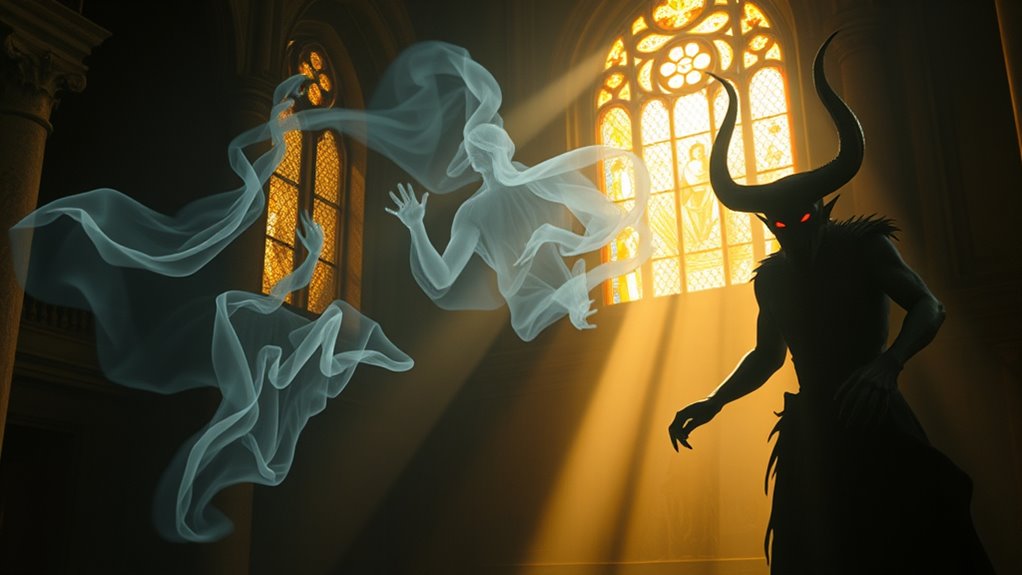
The spiritual and religious significance of demons and ghosts varies widely across cultures and belief systems, shaping how you interpret and respond to paranormal phenomena. Demons often embody ritualistic symbolism representing evil, temptation, or divine punishment, serving as spiritual lessons or warnings. Ghosts, on the other hand, are seen as spirits of the departed, symbolizing unresolved issues or spiritual connections to the living. These entities carry deep spiritual symbolism, influencing rituals, prayers, or ceremonies meant to ward off harm or honor ancestors. In many traditions, demons and ghosts are more than mere myth; they’re integral to understanding moral values and spiritual principles. Their significance shapes cultural practices and influences your perceptions of life, death, and the unseen forces that govern both.
How Demons and Ghosts Are Portrayed in Popular Media

In popular media, demons and ghosts are often exaggerated for dramatic effect, shaping how you perceive these entities beyond their traditional roots. You might imagine ghost sightings as chilling, unexplained phenomena or demon possession as intense, terrifying battles. To keep you hooked, here are four common portrayals:
- Ghost sightings are frequent in haunted houses, often captured on camera or in eerie stories.
- Demons are depicted as powerful, malevolent beings that possess individuals, causing chaos and fear.
- Movies show ghosts as restless spirits seeking closure, while demons are relentless predators.
- Possessed characters often exhibit supernatural strength, emphasizing the danger of demon possession.
These portrayals heighten fear but often distort the true nature of these entities.
The Difference in Their Origins and Existences
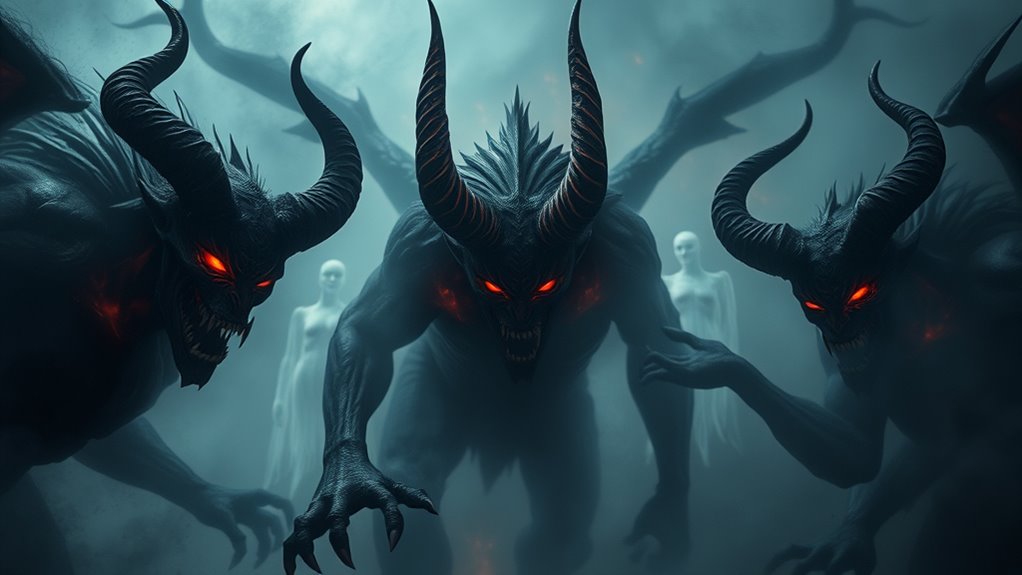
You might notice that demons often originate from mythology or religious texts, representing spiritual forces or moral battles. Ghosts typically stem from cultural stories about spirits of the dead, existing more as physical remnants or memories. By exploring these origins, you’ll see how their existence varies across cultures and beliefs, shaping how we perceive them today.
Origins in Mythology
Demons and ghosts originate from vastly different mythological backgrounds, shaping their roles and perceptions in stories and beliefs. You’ll find demons often linked to ancient rituals and mythical creatures from diverse cultures, representing chaos or evil forces. Ghosts, on the other hand, typically stem from beliefs about spirits of the deceased lingering in the mortal world. Here are key differences:
- Demons often appear in mythologies as malevolent beings born from chaos or divine punishment.
- Ghosts are seen as spirits of the dead, sometimes restless or seeking closure.
- Mythical creatures, like demons, are woven into stories as symbols of temptation or evil.
- Ancient rituals aimed to ward off or summon these entities, reflecting their deep-rooted presence in cultural mythologies.
Spiritual Vs Physical Existence
While demons are often considered spiritual entities rooted in myth and believed to possess supernatural powers beyond the physical domain, ghosts are generally seen as the spirits of deceased humans who remain tied to the mortal world. Demons originate from the spiritual domain, existing beyond physical constraints, and are thought to influence or interact with the physical domain through supernatural means. Ghosts, on the other hand, are believed to be the spirits of those who once lived in the physical domain, lingering after death due to unresolved issues or emotional ties. Their existence blurs the lines between worlds, but fundamentally, demons operate within the spiritual realm with origins in myth, whereas ghosts are spirits of the deceased, connected to the physical domain through their earthly ties.
Cultural Interpretations
Cultural interpretations shape how societies perceive demons and ghosts, often reflecting their unique beliefs, values, and historical contexts. Your understanding of these entities is deeply influenced by ancient rituals and cultural symbolism. For example:
- In Chinese culture, ghosts symbolize unsettled spirits needing closure through rituals like offerings.
- Western traditions often view demons as malevolent beings linked to moral struggles, rooted in religious stories.
- Indigenous rituals may invoke spirits or ancestors to maintain harmony, blurring the line between ghosts and demons.
- Ancient rituals reinforce societal values, shaping perceptions of what constitutes a demon or ghost.
These interpretations reveal that beliefs about spirits evolve with cultural narratives, making their origins complex and diverse across civilizations.
Methods of Exorcism and Spiritual Cleansing
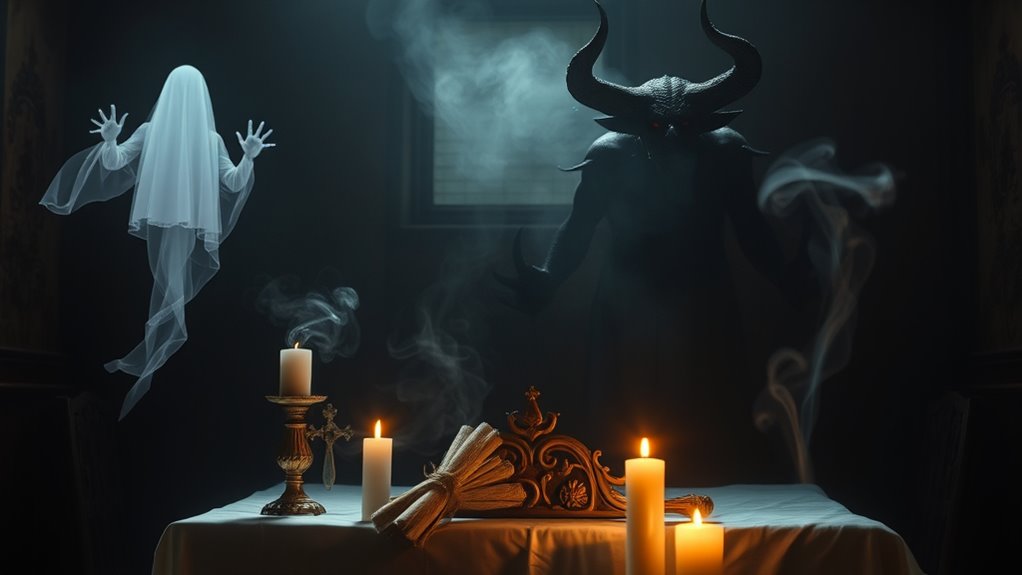
Methods of exorcism and spiritual cleansing have been practiced across cultures and religions for centuries, aiming to banish malevolent spirits and restore harmony. These practices often involve specific ritual tools and cleansing rituals designed to purify spaces or individuals. You might see rituals using sacred objects, prayers, or chants to invoke divine protection. Some traditions employ symbolic items like holy water, incense, or talismans to ward off spirits. Here’s a quick overview:
| Technique | Ritual Tools | Purpose |
|---|---|---|
| Spoken Prayers | Sacred texts, chants | Call upon divine aid |
| Holy Water | Water, blessings | Purify and cleanse |
| Incense | Incense sticks, smoke | Drive away negativity |
| Cleansing Rituals | Symbolic objects, rituals | Restore spiritual harmony |
The Impact of Demons and Ghosts on Modern Culture

You’ve probably seen demons and ghosts shape stories on screens and TV, influencing how we view the supernatural. Religious and cultural beliefs also keep these entities alive in traditions and practices around the world. Plus, haunted tours and events attract many, turning fears into experiences that keep these spirits in the public eye.
Films and Television Portrayals
Films and television have played a significant role in shaping how we comprehend demons and ghosts, often blurring the line between myth and reality. Your perception is influenced by popular portrayals that mix horror, folklore, and fantasy. Here are four ways they impact you:
- They popularize vampire myths, making them seem more real and infiltrating modern stories.
- Alien encounters are often depicted as supernatural phenomena, intertwining demons and extraterrestrials.
- Haunted house stories heighten fears, linking ghosts to psychological and cultural anxieties.
- Horror series and movies dramatize demon possessions, reinforcing stereotypes and misconceptions.
These portrayals shape your understanding, often emphasizing the supernatural over scientific explanations. As a result, you might find it harder to distinguish between myth and reality when encountering stories about demons and ghosts.
Religious and Cultural Beliefs
Religious and cultural beliefs deeply influence how societies perceive demons and ghosts, shaping rituals, stories, and moral lessons. Ancient rituals often aimed to ward off malevolent spirits or seek protection from ghosts, reflecting deep-rooted fears and respect. These beliefs persist today, transforming into modern practices like exorcisms or spiritual cleansings. In many cultures, demons symbolize evil forces, while ghosts represent spirits of the dead, influencing moral lessons and societal norms. These perceptions shape not only religious ceremonies but also popular culture, inspiring movies, festivals, and folklore. Whether rooted in ancient rituals or modern beliefs, the way societies interpret demons and ghosts reveals their ongoing desire to understand life, death, and the unseen forces that influence human existence.
Haunted Tourism and Events
Haunted tourism and events have become a popular way for people to experience the eerie allure of demons and ghosts firsthand, transforming fear into entertainment. You can explore haunted attractions or participate in paranormal investigations, immersing yourself in spooky stories and chilling encounters. These experiences are shaped by modern culture’s fascination with the supernatural, often inspired by folklore and media. Here are four ways haunted tourism impacts society:
- Boosts local economies through themed events and attractions
- Fuels popular horror media and storytelling traditions
- Encourages community engagement with ghost walks and festivals
- Provides entertainment while exploring cultural beliefs about spirits and demons
Whether you’re seeking thrills or curiosity, these events keep the mysteries of demons and ghosts alive in today’s culture.
Frequently Asked Questions
Can Demons and Ghosts Coexist in the Same Mythological Stories?
You might wonder if demons and ghosts coexist in stories. In many mythologies, they do, often appearing together in tales of demonic hauntings or ghostly possessions. These stories blend supernatural elements, showing demons tormenting spirits or possessing humans alongside ghostly apparitions. Such narratives highlight the complex relationship between these entities, making it clear that, in myth, demons and ghosts often coexist, creating rich, layered supernatural worlds.
Are There Any Scientific Explanations for Encounters With Ghosts or Demons?
You might wonder if science explains encounters with ghosts or demons. Paranormal research investigates these phenomena, but scientific skepticism remains cautious due to lack of empirical evidence. Most scientists attribute ghost sightings to psychological factors like hallucinations, sleep paralysis, or environmental influences. Similarly, demonic encounters often have psychological or cultural explanations. While some claim technological tools detect spirits, mainstream science continues to seek rational explanations, emphasizing the need for rigorous evidence before accepting supernatural claims.
How Do Different Religions Interpret the Existence of Demons Versus Ghosts?
You might notice that different religions interpret demons and ghosts differently. For instance, some see demons as malevolent spiritual beings causing demonic possession, often requiring spiritual exorcism. Others believe ghosts are spirits of the deceased lingering in the mortal domain, with less emphasis on exorcism. These perspectives shape how believers understand supernatural encounters, emphasizing spiritual battles against evil versus honoring ancestors’ spirits.
What Are the Psychological Effects of Believing in Demons or Ghosts?
You might think believing in demons or ghosts is harmless fun, but it can have a surprising psychological impact. It may heighten anxiety, cause paranoia, or disrupt your mental health, especially if you’re already vulnerable. Ironically, these beliefs can create a cycle of fear that’s hard to break, affecting your overall well-being. Recognizing this influence helps you understand how such fears shape your mental health, for better or worse.
Are There Cultural Practices to Protect Against or Appease Demons and Ghosts?
You might participate in rituals of protection or appeasement ceremonies to ward off or honor spirits and demons. Many cultures have specific practices, like burning incense, offering food, or reciting prayers, to keep negative entities at bay. These rituals serve to comfort communities and reinforce spiritual beliefs, helping individuals feel safer and more connected to their traditions. Such customs vary worldwide but share the common goal of maintaining harmony with unseen forces.
Conclusion
Understanding demons and ghosts helps you see their unique roles in cultures worldwide. Did you know that 68% of people believe in spirits or supernatural beings? This shows how deeply these entities influence our beliefs and stories. By debunking myths and exploring their origins, you can better appreciate their significance in history and media. Keep questioning and exploring—your perspective on these mysterious beings will become clearer and more informed.


